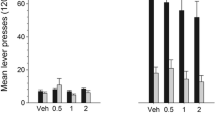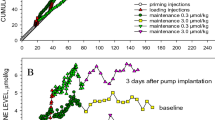Abstract
The effect of the selective D1 antagonist, SCH 23390, and the selective D2 antagonist, spiperone, was investigated in rats trained to self-administer intravenous cocaine on a fixed-ratio (FR) 5 schedule of reinforcement. Both SCH 23390 and spiperone pretreatment increased responding up to doses of 10.0 µg/kg, and decreased responding at higher doses. Since rate of responding maintained by a drug can be influenced by factors other than its reinforcing efficacy, behavior maintained by cocaine was also investigated under a progressive-ratio schedule. The breaking point obtained under this schedule is used as a measure of the efficacy of the reinforcer and this value is not exclusively determined by response rate. With the progressive-ratio schedule, both SCH 23390 and spiperone produced dose-dependent decreases in the highest ratio completed in rats self-administering cocaine. The results obtained using the FR 5 and progressive-ratio schedules suggest that both D1 and D2 receptors are involved in mediating the reinforcing effects of cocaine.
Similar content being viewed by others
References
Arnt J, Hyttel J (1984) Differential inhibition by dopamine D-1 and D-2 antagonists of circling behavior induced by dopamine agonists in rats with unilateral 6-hydroxydopamine lesions. Eur J Pharmacol 102:349–354
Arnt J, Hyttel J (1985) Differential involvement of dopamine D-1 and D-2 receptors in the circling behavior induced by apomorphine, SK & F 38393, pergolide and LY 171555 in 6-hydroxydopamine-lesioned rats. Psychopharmacology 85:346–352
Bedford JA, Bailey LP, Wilson MC (1978) Cocaine reinforced progressive ratio performance in the rhesus monkey. Pharmacol Biochem Behav 9:631–638
Billard W, Ruperto V, Crosby G, Iorio LC, Barnett A (1984) Characterization of the binding of3H-SCH 23390, a selective D-1 receptor antagonist ligand, in rat striatum. Life Sci 35:1885–1893
Christensen AV, Arnt J, Hyttel J, Larsen JJ, Svendsen O (1984) Pharmacological effects of a specific dopamine D-1 antagonist SCH 23390 in comparison with neuroleptics. Life Sci 34:1529–1540
Creese I, Sibley DR, Hamblin MW, Leff SE (1983) The classification of dopamine receptors: relationship to radioligand binding. Annu Rev Neurosci 6:43–71
de Wit H, Wise RA (1977) Blockade of cocaine reinforcement in rats with the dopamine receptor blocker pimozide, but not with the noradrenergic blockers phentolamine or phenoxybenzamine. Can J Psychol 31:195–203
Ettenberg A, Pettit HO, Bloom FE, Koob GF (1982) Heroin and cocaine intravenous self-administration in rats: mediation by separate neural systems. Psychopharmacology 78:204–209
Freedman SB, Mustafa AA, Poat JA, Senior KA, Wait CP, Woodruff GN (1981a) A study on the localization of [3H]sulpiride binding sites on rat striatal membranes. Neuropharmacology 20:1151–1155
Freedman SB, Poat JA, Woodruff GN (1981b) [3H]Sulpiride, a ligand for neuroleptic receptors. Neuropharmacology 20:1323–1326
Griffiths RR, Brady JV, Snell JD, (1978) Progressive-ratio performance maintained by drug infusions: comparison of cocaine, diethylpropion, chlorphentermine, and fenfluramine. Psychopharmacology 56:5–13
Griffiths RR, Bradford LD, Brady JV (1979) Progressive ratio and fixed ratio schedules of cocaine-maintained responding in baboons. Psychopharmacology 65:125–136
Hadfield MG, Nugent EA (1983) Cocaine: comparative effect on dopamine uptake in extrapyramidal and limbic systems. Biochem Pharmacol 32:744–746
Heikkila RE, Orlansky H, Cohen G (1975) Studies on the distinction between uptake inhibition and release of (3H) dopamine in rat brain tissue slices. Biochem Pharmacol 24:847–852
Hertting G, Axelrod J, Whitby LG (1961) Effect of drugs on the uptake and metabolism of3H-norepinephrine. J Pharmacol Exp Ther 134:146–153
Hodos W (1961) Progressive ratio as a measure of reward strength. Science 134:943–944
Hodos W, Kalman J (1963) Effects of increment size and reinforcer volume on progressive ratio performance. J Exp Anal Behav 6:387–392
Hoffman DC, Dickson PR, Beninger RJ (1988) The dopamine D2 receptor agonists, quinpirole and bromocriptine produce conditioned place preferences. Prog Neuropsychopharmacol Biol Psychiatry 12:315–322
Hyttel J (1978) A comparison of the effect of neuroleptic drugs on the binding of3H-haloperidol and3H-cis(z)-flupenthixol and on adenylate cyclase activity in rat striatal tissue in vitro. Prog Neuropsychopharmacol 2:329–335
Hyttel J (1981) Similarities between the binding of3H-flupenthixol to rat striatal dopamine receptors in vitro. Life Sci 28:563–569
Hyttel J (1983) SCH 23390-the first selective dopamine D-1 antagonist. Eur J Pharmacol 91:153–154
Iorio LC, Barnett A, Leitz FH, Houser VP, Korduba CA (1983) SCH 23390, a potential benzazepine antipsychotic with unique interactions on dopaminergic systems. J Pharmacol Exp Ther 226:462–468
Johanson CE, Kandel DA, Bonese K (1976) The effects of perphenazine on self-administration behavior. Pharmacol Biochem Behav 4:427–433
Kebabian JW, Calne DB (1979) Multiple receptors for dopamine. Nature 277:93–96
Kleven MS, Anthony EW, Goldberg LI, Woolverton WL (1988) Blockade of the discriminative stimulus effects of cocaine in rhesus monkeys with the D1 dopamine antagonist SCH 23390. Psychopharmacology 95:427–429
Koob GF, Le HT, Creese I (1987a) The D1 dopamine receptor antagonist SCH 23390 increases cocaine self-administration in the rat. Neurosci Lett 79:315–320
Koob GF, Vaccarino F, Amalric M, Bloom FE (1987b) Positive reinforcement properties of drugs: search for neural substrates. In: Engel J, Oreland L (eds) Brain reward systems and abuse. Raven Press, New York, pp 35–50
Leone P, Di Chiara G (1987) Blockade of D-1 receptors by SCH 23390 antagonizes morphine- and amphetamine-induced place preference conditioning. Eur J Pharmacol 135:251–254
Molloy AG, Waddington JL (1984) Dopaminergic behavior stereospecifically promoted by the D1 agonist R-SK & F 38393 and selectively blocked by the D1 antagonist SCH 23390. Psychopharmacology 82:409–410
Morelli M, Di Chiara G (1985) Catalepsy induced by SCH 23390 in rats. Eur J Pharmacol 117:179–185
Nielsen EB, Jepsen SA (1985) Antagonism of the amphetamine cue by both classical and atypical antipsychotic drugs. Eur J Pharmacol 111:167–176
Pettit HO, Ettenberg A, Bloom FE, Koob GF (1984) Destruction of dopamine in the nucleus accumbens selectively attenuates cocaine but not heroin self-administration in rats. Psychopharmacology 84:167–173
Pickens R, Thompson T (1968) Cocaine-reinforced behavior in rats: effects of reinforcement magnitude and fixed-ratio size. J Pharmacol Exp Ther 161:122–129
Roberts DCS, Koob GF (1982) Disruption of cocaine self-administration following 6-hydroxydopamine lesions of the ventral tegmental area in rats. Pharmacol Biochem Behav 17:901–904
Roberts DCS, Vickers G (1984) Atypical neuroleptics increase self-administration of cocaine: an evaluation of a behavioral screen for antipsychotic activity. Psychopharmacology 82:135–139
Roberts DCS, Corcoran ME, Fibiger HC (1977) On the role of ascending catecholaminergic systems in intravenous self-administration of cocaine. Pharmacol Biochem Behav 6:615–620
Roberts DCS, Koob GF, Klonoff P, Fibiger HC (1980) Extinction and recovery of cocaine self-administration following 6-hydroxydopamine lesions of the nucleus accumbens. Pharmacol Biochem Behav 12:781–787
Roberts DCS, Loh EA, Vickers G (1989) Self-administration of cocaine on a progressive ratio schedule in rats: dose-response relationship and effect of haloperidol pretreatment. Psychopharmacology 97:535–538
Rosengarten H, Schweitzer JW, Friedhoff AU (1983) Induction of oral dyskinesias in naive rats by D1 stimulation. Life Sci 33:2479–2482
Ross SB, Renyi AL (1969) Inhibition of the uptake of tritiated 5-hydroxytryptamine in brain tissue. Eur J Pharmacol 7:270–277
Spealman RD, Kelleher RT (1979) Behavioral effects of self-administered cocaine: responding maintained alternately by cocaine and electric shock in squirrel monkeys. J Pharmacol Exp Ther 210:206–214
Stoof JC, Kebabian JW (1984) Two dopamine receptors: biochemistry, physiology and pharmacology. Life Sci 35:2281–2296
Taylor D, Ho BT (1978) Comparison of inhibition of monoamine uptake by cocaine, methylphenidate and amphetamine. Res Commun Chem Pathol Pharmacol 21:67–75
Theodorou A, Crocket M, Jenner P, Marsden CD (1979) Specific binding of [3H]sulpiride to rat striatal preparations. J Pharm Pharmacol 31:424–426
Weeks JR (1972) Long-term intravenous infusion. In: Myers RD (ed) Methods in psychobiology, vol 2. Academic Press, London, pp 155–168
Woolverton WL (1986) Effects of a D1 and a D2 dopamine antagonist on the self-administration of cocaine and piribedil by rhesus monkeys. Pharmacol Biochem Behav 24:531–535
Woolverton WL, Virus RM (1989) The effects of a D1 and a D2 dopamine antagonist on behavior maintained by cocaine or food. Pharmacol Biochem Behav 32:691–697
Author information
Authors and Affiliations
Rights and permissions
About this article
Cite this article
Hubner, C.B., Edward Moreton, J. Effects of selective D1 and D2 dopamine antagonists on cocaine self-administration in the rat. Psychopharmacology 105, 151–156 (1991). https://doi.org/10.1007/BF02244301
Received:
Revised:
Issue Date:
DOI: https://doi.org/10.1007/BF02244301




